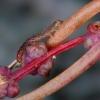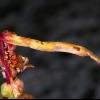35.115 Scrobipalpa nitentella (Fuchs, 1902)
Status and Distribution
Widely scattered but local, occasionally locally common, predominantly in coastal areas of the British Isles. Apparently absent from the Northern and Western Isles of Scotland, most of western Ireland and the Channel Islands. Occasionally wanders some distance away from its breeding areas.
If a specimen was not available for subsequent examination, some historic records of S. obsoletella may include those of this species, from which it was not distinguished until 1935.

Provisional map
Pupa
Foodplant and Larval Feeding Signs
Chenopodium spp. (goosefoot), see plant distribution map for C.album agg. as a representative of this foodplant, and Suaeda maritima (annual sea-blite). Also recorded from Atriplex littoralis (grass-leaved orache), A. patula (common orache),A. portulacoides (sea-purslane), A. prostrata (spear-leaved orache), Beta vulgaris ssp. maritima (sea beet), Sarcocornia perrenis (perrenial glasswort) and Salicornia sp. (bred, VC9 in 2016).
In Europe also on Atriplex hortensis (garden orache), Atriplex pedunculata (pedunculate sea-purslane), Salicornia europaea agg. (common glasswort) and Suaeda altissima.
A record of the larva on Cakile maritima (sea rocket) is very unusual and it is considered possible the plant was misidentified.
Mines the leaves with the first instar producing a U or horseshoe-shaped mine.
Finding the Moth
Larval: mines the leaves with the first instar producing a U or horseshoe-shaped mine, then mining in an irregular or branched fashion. In the penultimate instar the larva vacates the mine and spins a silken tube amongst the seeds, feeding mainly on the unripe ones.
Adult: can be disturbed from amongst the foodplant during the day, flies at night and comes to light often some distance form its nearest foodplant.
Similar Species
Can be confused with S. salinella, S. obsoletella, S. instabilella, some forms of S. samadensis and one form of S. suaedella. Dissection is often required to confirm the determination.
Because of the sometimes considerable variation within most saltmarsh inhabiting Scrobipalpa species, identification by wing markings alone will not often be possible. Caution and care are the watchwords for this group.
If a moth has been bred from a known foodplant, and therefore also time of year when the larva feeds and the nature of its feeding methods have been observed, this information, plus a freshly emerged moth, will allow the number of possibilites to be reduced considerably. If the bred or caught moth is a fresh specimen AND displays the distinctive markings of some species (see below) then an identification without more detailed examination should be possible in many cases.
Those more readily identifiable when freshly emerged by the forewing markings are listed below. However all of these also have variation in their wing markings which, when the obvious features are obscured or worn, will then resemble some other Scrobipalpa species.
Scrobipalpa suaedella - those with an obvious clear pale ochreous dorsal quarter to the forewing.
Scrobipalpa obsoletella - those with the forewing a pale greyish colour lacking any red-brown colouration and appearing paler in the final one-third due to a pale postmedial fascia.
Scrobipalpa ocellatella - those with the prominent angled fascia at three quarters on the forewing and dark markings contrasting with the surrounding paler ground colour.
In cases where there is any doubt, particularly where worn light-trapped specimens are concerned, dissection will be essential to obtain an accurate identification until a good familiarity is built up with the range of species and their markings at a particular site.
Even genitalia differences are often small but are constant between the various species. It is advisable to seek confirmation of identifications by genitalia until familiarity is built up with this genus.
Single brooded, mid-June to early September.
Earliest: 3rd June 2008 (VC9)
Latest: 16th September 2012 (VC9)








%20Orkney%2022.6.24%20B%20Hamill_0.jpg)









